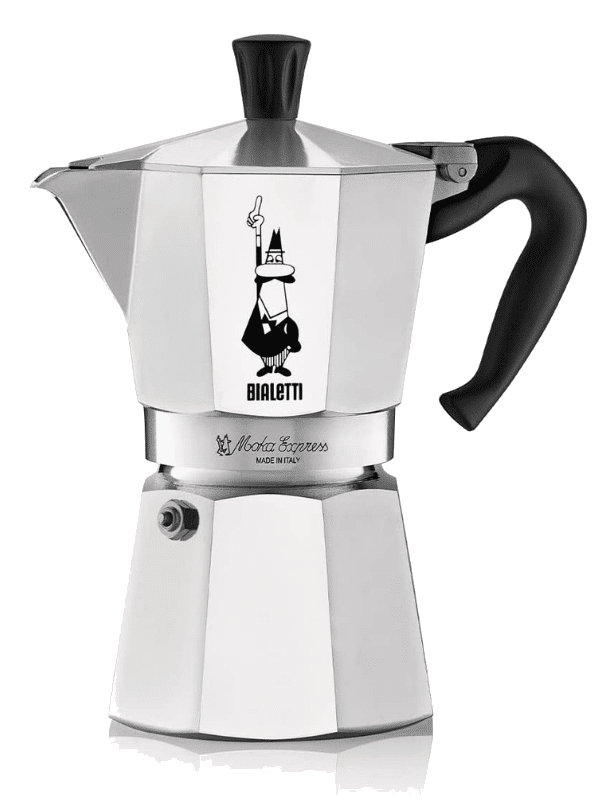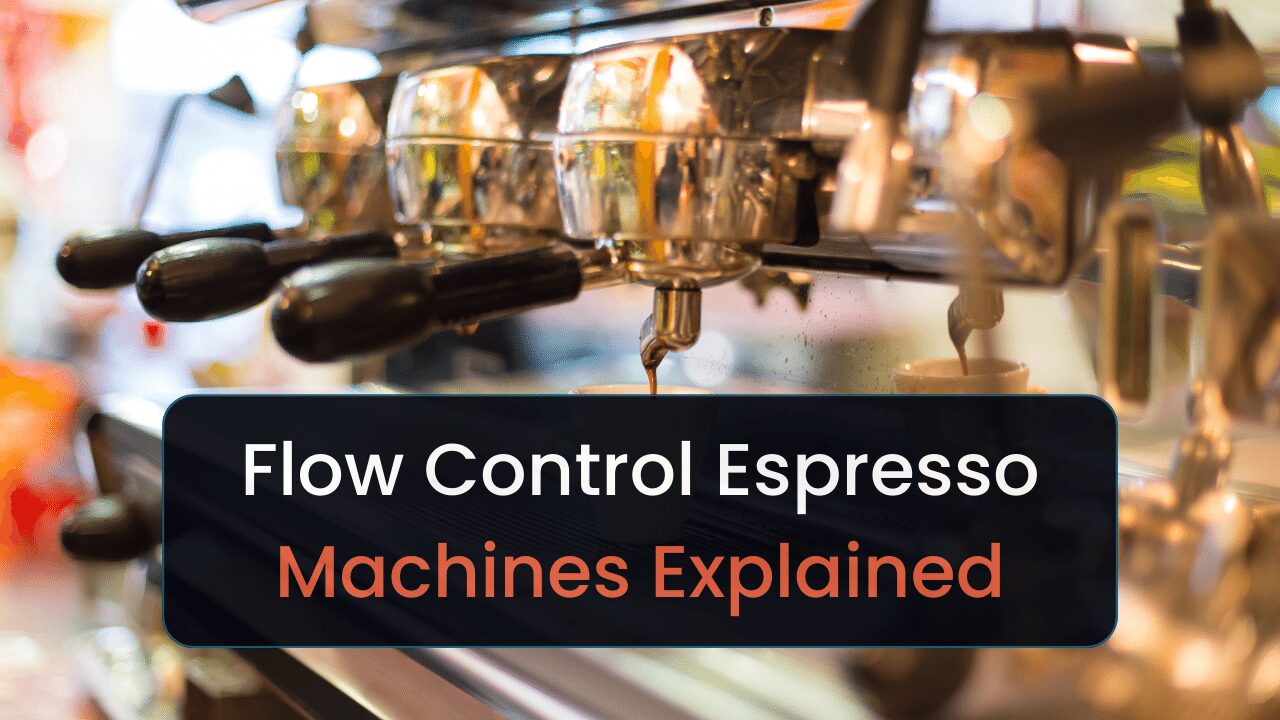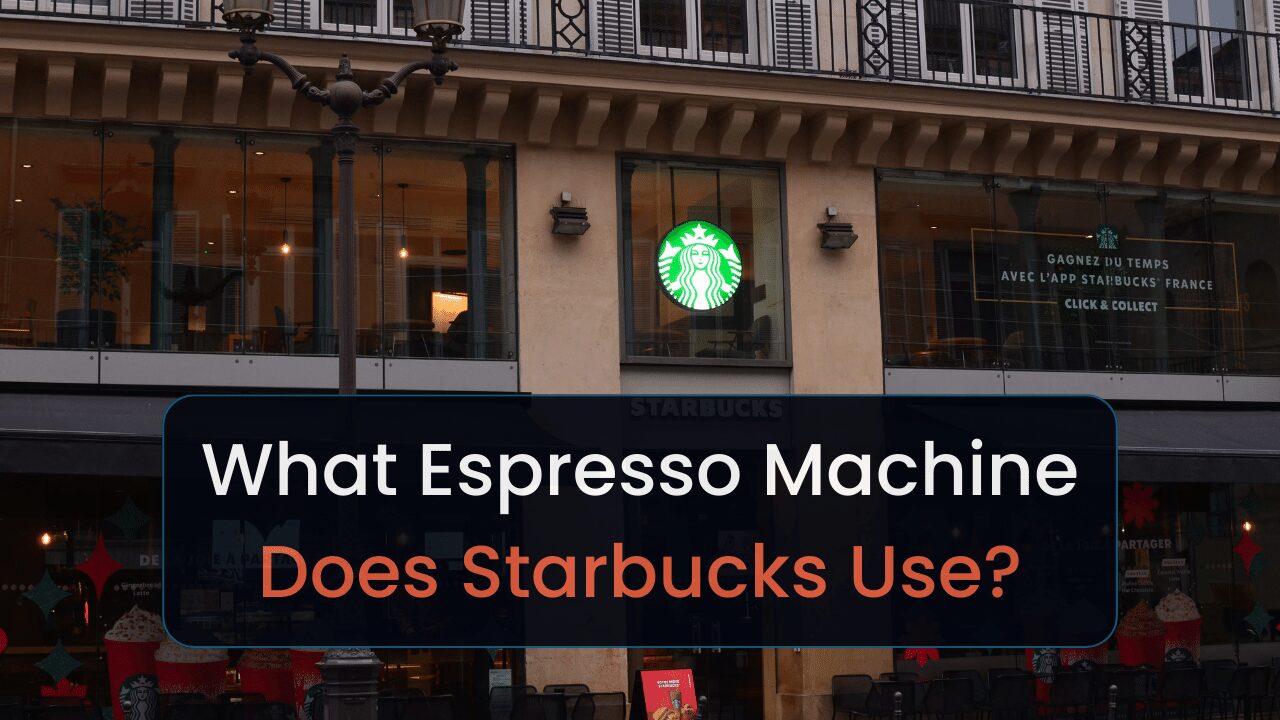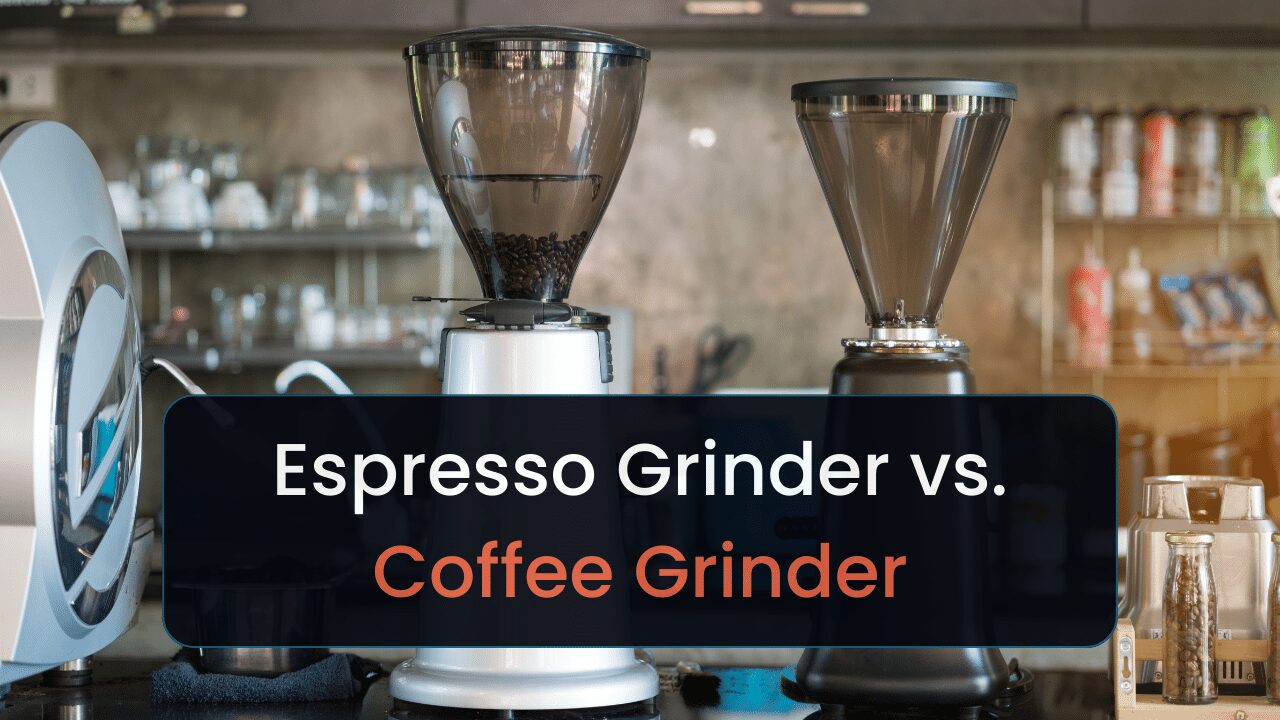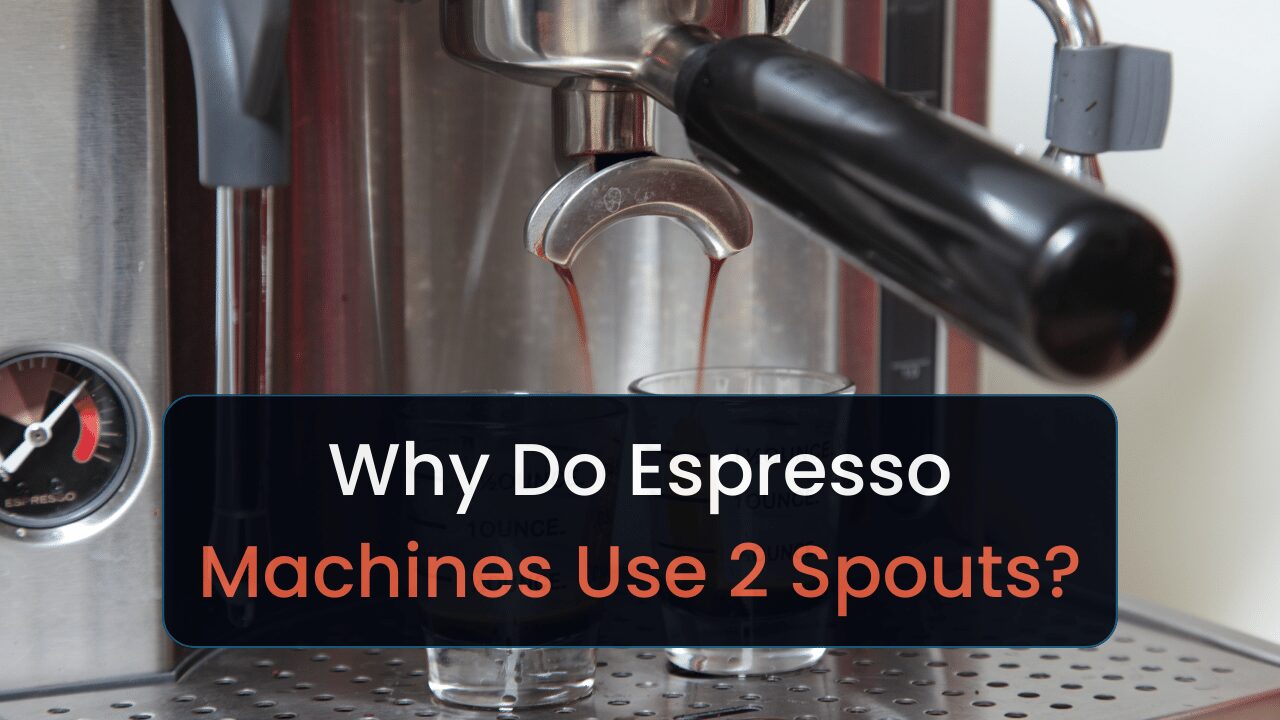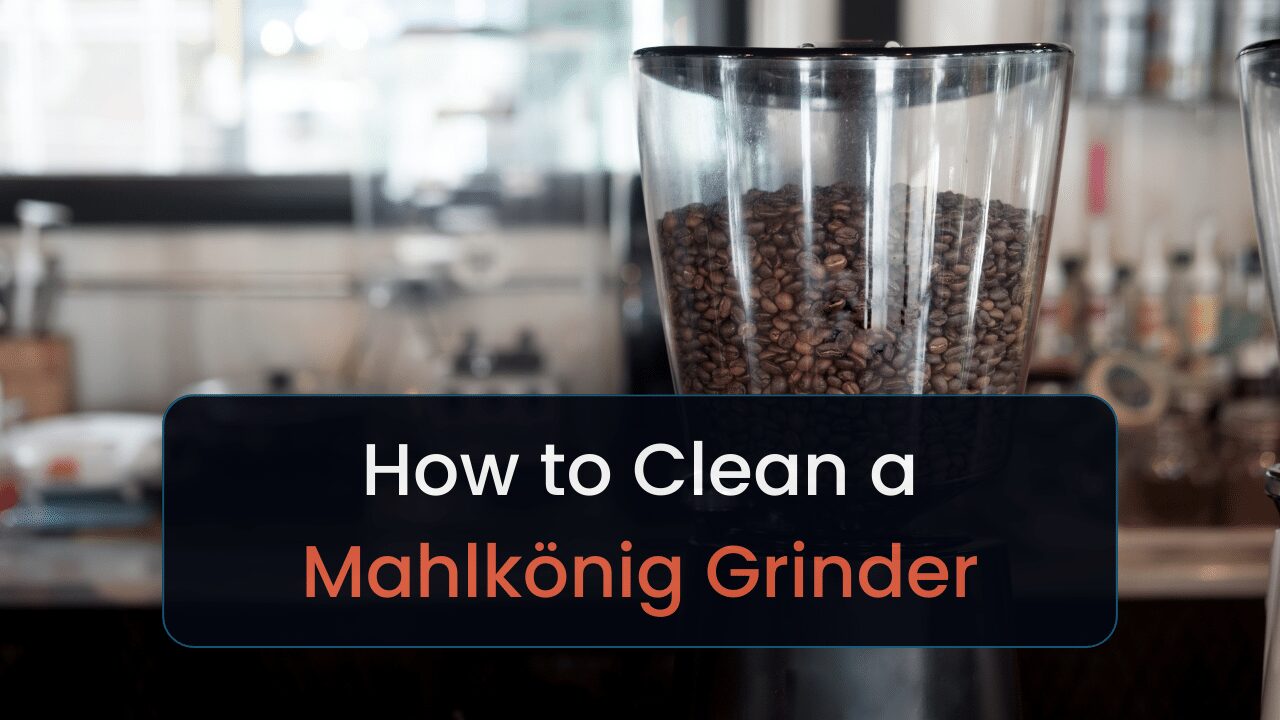Explore this guide to find the best espresso machines for tight spaces.
I must balance living in a studio apartment and succumbing to my espresso addiction. That led me to search for the best compact espresso machines.
The De’Longhi Stilosa is our number 1 recommended small device because it’s durable. And the fact it’s a semi-automatic machine means that it’ll automate bits of the espresso-making process for you.
It might be a bit too wide for some kitchens, nor ideal for traveling. Don’t worry, I’ve covered a bunch of alternatives.
Let’s hunt for some machines.
Top 9 Best Small Espresso Machines
Small espresso makers I’ll compare include:
- De’Longhi Stilosa: Best Overall
- Capresso Espresso Machine: Best Budget Machine for Beginners
- PHILIPS 3200: Best Machine w/ a Grinder
- Gevi Espresso Machine: Best Machine w/ Frother
- AeroPress Go Portable: Best for Portability
- Bialetti Moka Express: Best Stovetop Maker
- Breville Bambino Plus: Best for Australians
- De’Longhi Bar: Best for Canadians
- De’Longhi Dedica: Best for Folks in Britain
Top 9 Best Compact Espresso Machines
All the machines I’ll cover work for anyone who lacks counter space for larger machines. However, that’ll likely mean you must sacrifice quality-of-life features (e.g., built-in grinders). The following sections will cover the specs, pros and cons, and details of each choice.
Before moving on, here’s a legend that may clear up confusion:
- Dimensions:
- D: depth
- W: width
- H: height
- PID = proportional integral derivative: monitors water temperature & makes minor adjustments to keep it to a set temperature.
- ESE = Easy Serve Espresso: pods with pre-ground beans to make brewing drinks easier.
In the bullet points preceding each section, you may encounter perplexing terminology. For clarification, refer to the “Buyer’s Guide” section where I provide explanations for these terms.
These prices could change at any time. Use them for reference and nothing else.
If you’re looking for commercial models, you can find all our compact espresso machines for sale.
If you need a 2-group, you should check out our collection of compact 2-group espresso machines.
Let the games begin.
1. De’Longhi Stilosa: Best Overall Small Espresso Machine

| Price | $$ |
| Type | Semi-automatic |
| Dimensions | 8.07 x 13.5 x 11.22 in (D, W, H) |
| Bars of pressure | 15 bars |
| Boiler type | single |
| Warranty | 1 year |
| Milk frother | Yes |
| Water capacity | 42 oz or 42 solo shots |
Pros
- Affordable price.
- Compact design
- Easy to use & clean
- Stainless steel boiler
Cons
- Stiff steamed milk
I’ve listed the Stilosa as the best espresso machine in different posts (various categories) since it’s an affordable coffee maker that’s beginner-friendly. And it includes everything a beginner and intermediate barista could desire.
Starting with the milk frother. It’s essential for adding oxygen to milk to make beverages like cappuccinos, lattes, and macchiatos.
The stainless steel boiler will ensure it lasts for years, though I couldn’t find how long, on average, it lasts. The 15 bars of pressure this machine exerts pairs well with the former feature, as it’s an excellent extraction strength for espresso makers.
The machine may prove a bit large for smaller kitchens. Meaning, it’s challenging to store, but could serve as a nice decorative piece due to its contemporary design.
2: Capresso: Best Small Budget Espresso Machine for Beginners
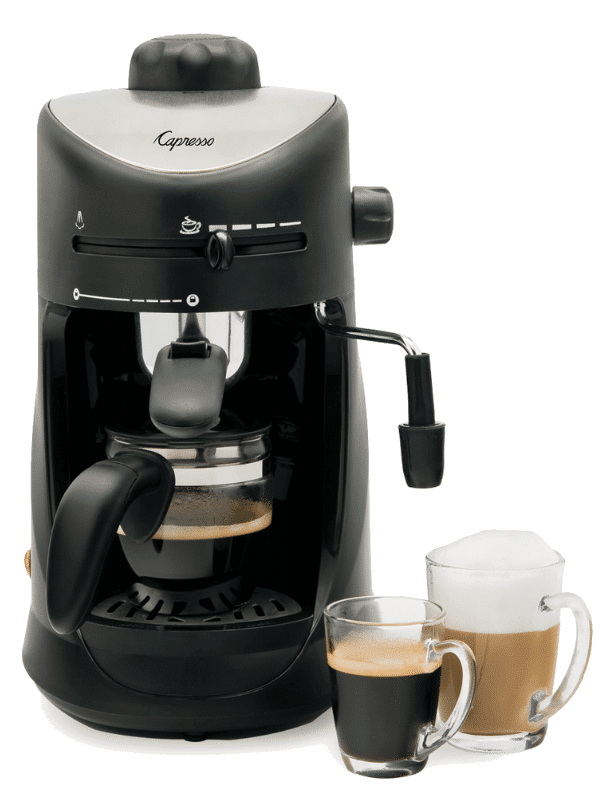
| Price | $ |
| Type | Semi-automatic |
| Dimensions | 9.75 x 7.5 x 13.25 in (D, W, H) |
| Bars of pressure | 15 bars |
| Boiler type | single |
| Warranty | 1 year |
| Milk frother | Yes |
| Water capacity | 10 oz or 10 solo shots |
Pros
- Affordable price
- Compact design
Cons
- Noisy operation
- Plastic parts
- Small water tank
- Inconsistent pressure
The low price, 15 bars of pressure, compact size, and included milk frother makes Capresso’s unsightly machine an ideal choice for beginners on a budget. The milk frother allows you to make milk-based drinks like cappuccinos.
Most folks agree that 15 bars of pressure are ideal for making drinks. As it prevents you from over-extracting and under-extracting your coffee drinks. I’ll cover more information on under- and over-extraction later.
The compact(ness) allows you to hide this machine from anyone worried about judging your espresso machine choice. And if they ask where your machine went, tell them it’s in the mail.
Consider a different machine if you live with someone who likes drinking espresso at the same time of day. It’ll take around 2 minutes for this machine to warm up, and it has a single portafilter spout. Meaning, it can brew one shot at a time.
3: PHILIPS 3200 Series: Best Small Espresso Machine With Grinder
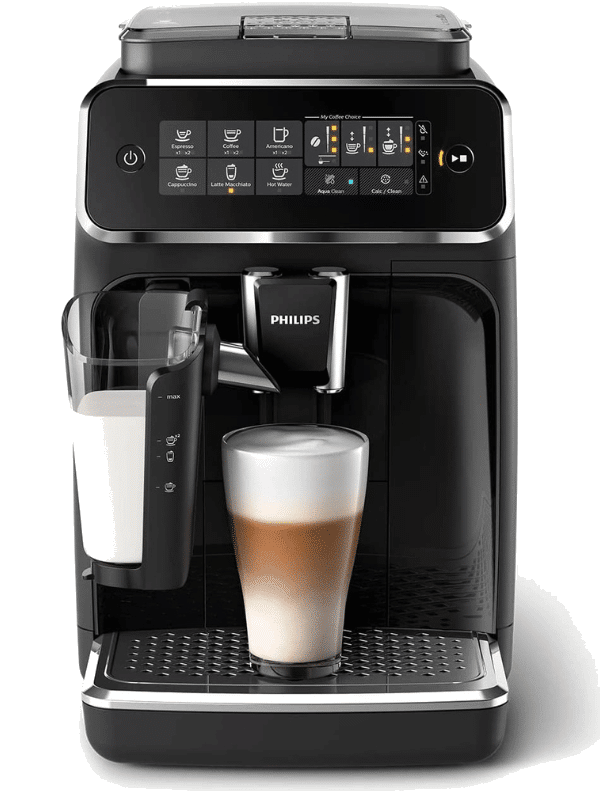
| Price | $$ |
| Type | Semi-automatic |
| Dimensions | 10 x 17 x 15 in (D, W, H) |
| Bars of pressure | 15 bars |
| Boiler type | single |
| Warranty | 2 years |
| Milk frother | Yes |
| Water capacity | 60.9 oz or 60 solo shots |
Pros
- Minimal maintenance needed
- Easy cleanup with removable parts
- Custom recipe buttons
Cons
- Expensive
- Noisy grinder
- Plastic exterior
PHILIPS’ coffee maker looks a bit cheap due to the exterior and lack of a frothing wand, but it has an excellent trade-off. For starters, look at the user interface. Create single- or double-shot Americanos or coffees by pressing a button.
In the mood for a cappuccino? Press that button.
The AquaClean filters and calcification notification ease the burden of cleaning your machine. The former helps prevent limescale buildup. And the latter lets you know when it’s time to descale your machine.
The 3200 Series includes a ceramic burr grinder. This material’s great for grinders, as it prevents the machine from overheating. Ideal if you’re grinding a bunch of beans back-to-back. Because of this perk, the machine will support grinds for up to 20,000 cups.
Drink 2 drinks daily; those burrs will last you around 27 years.
Since it’s a super-automatic machine, the additional features like the grinder make it take up more space. Meaning, it’s not ideal for folks who have a super small kitchen.
Lastly, the coffee maker has an Aroma Seal container. Usually, you want to store coffee beans in the freezer to retain your beans’ flavors and aromas. But this container does that for you.
4. Gevi Espresso Machine: Best Small Espresso Machine With Frother
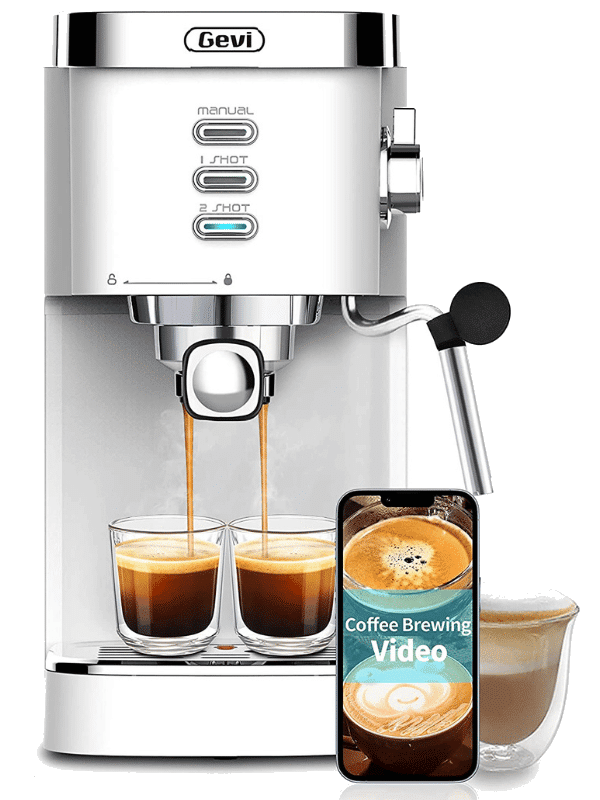
| Price | $$ |
| Type | Semi-automatic |
| Dimensions | 9.52 x 7.32 x 12.2 in (D, W, H) |
| Bars of pressure | 15 bars |
| Boiler type | single |
| Warranty | 1 year |
| Milk frother | Yes |
| Water capacity | 42 oz or 42 solo shots |
Pros
- Affordable price.
- Good flavor & crema
- Steam wand
Cons
- Low pressure
- Noisy operation
- Plastic parts
I was almost blinded when I saw the silver and white color combination when looking at this machine. But, it’s a perfect fit for kitchens with light color schemes. And its compact size allows the Gevi to fit in tight spaces.
You’re likely not only here for a pretty espresso maker.
The Gevi has 3 buttons; manual (control your coffee flow), single shot, and double shots. The latter 2 buttons take the guesswork out of figuring out how much espresso you should make. Consider Easy Serve Espresso (ESE) pods to increase the machine’s convenience further.
They’re pods with grounded and measured espresso beans that’ll make your life easier. Having these pods also eliminates the need for a separate coffee grinder, which would demand more counter space.
The Gevi supports single- and double-shot ESE pods.
Otherwise, it includes an NTC temperature control system, to ensure your drinks have a consistent temperature. Resulting in better taste.
The narrow size makes it great for small kitchens, studio apartments, and coffee carts.
Speaking of. If you want a great-tasting cappuccino, you can make it with this machine because of the milk frother. This device will also give you the means to create a base for latte art.
5. AeroPress Go Portable Coffee Press Kit: Best Portable Espresso Maker
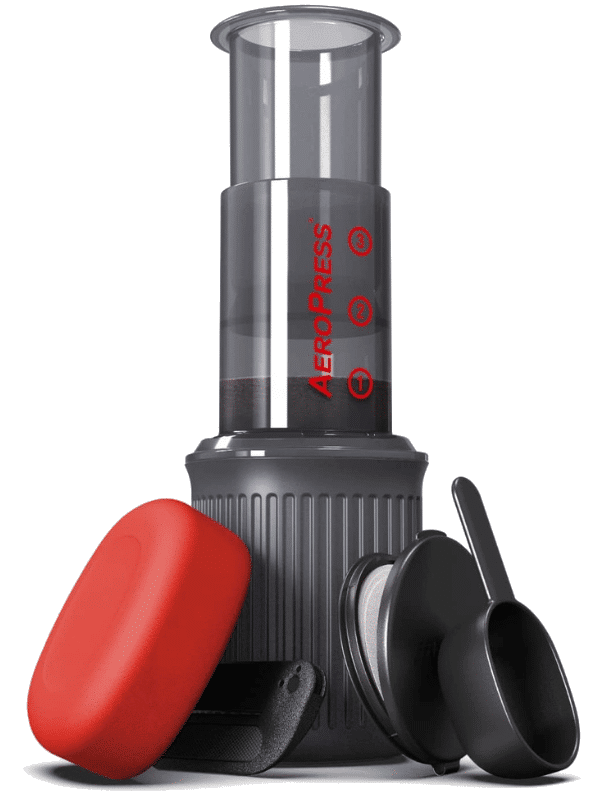
| Price | $ |
| Type | AeroPress |
| Dimensions | 4.75 x 4.75 x 11.75 in (D, W, H) |
| Warranty | 1 year |
| Water capacity | 10 oz or 1 cup |
Pros
- Compact & travel-friendly
- Easy to use & clean
- Thick, durable plastic
- No electricity required
Cons
- Small capacity
- Folding stir stick is flimsy
- Mug isn’t insulated
Before you scream at your screen and tell me this isn’t an espresso maker, it’s the only “portable” option you got. I also found the Outin Nano. But after thoroughly researching it, I had PTSD from similar “portable espresso makers” and how they quickly broke on me.
AeroPress coffee makers produce “espresso-style” concentrated coffee by using the regular brewing method. Not immersion, because that’ll give you pour-over black coffee.
And it’s possible to achieve a crema-like texture using this method.
If you don’t believe me, here’s a video that proves me right:
I digress:
The AeroPress is durable due to its thick plastic parts, but requires you to carry paper filters.
Regardless, it’s the best option for an espresso-like taste that you can carry while traveling. If you’re a one-bag traveler flying overseas, it’ll fit in your bag with no issues. And the 8 oz (226 g) won’t break your carry-on weight limit.
6. Bialetti Moka Express: Best Stovetop Espresso Maker
Pros
- Classic design
- Simple to use due to lack of buttons
- Flavorful coffee
- Will last over 10 years
Cons
- Not “true” espresso.
- Requires careful cleaning
- Prone to over-extraction
- Not compatible with induction stoves
Like with the AeroPress, a Moka (or stovetop coffee maker), will give you an espresso-like taste due to the very concentrated coffee. But unlike the AeroPress, achieving crema is a bit more complicated. As you’ll need to tinker with various grind sizes.
That doesn’t matter if you want a very budget-friendly espresso(ish) maker that looks great and can work well for camping. And unlike the AeroPress, it doesn’t require single-use filters. Making it a bit more environmentally friendly.
The larger size options make it ideal for making concentrated coffee drinks for multiple people. For instance, you could choose from a Moka maker that brews 1 through 12 cups.
Before buying, heed this warning.
Most Moka pots are made from aluminum, which isn’t magnetic. They won’t work if you try to use them on an induction stove, which works with magnetic metals (e.g., stainless steel).
Bialetti has stainless steel stovetop makers; you’ll need to conduct further research to find those.
7. Breville Bambino Plus: Best Small Espresso Machine, Australia
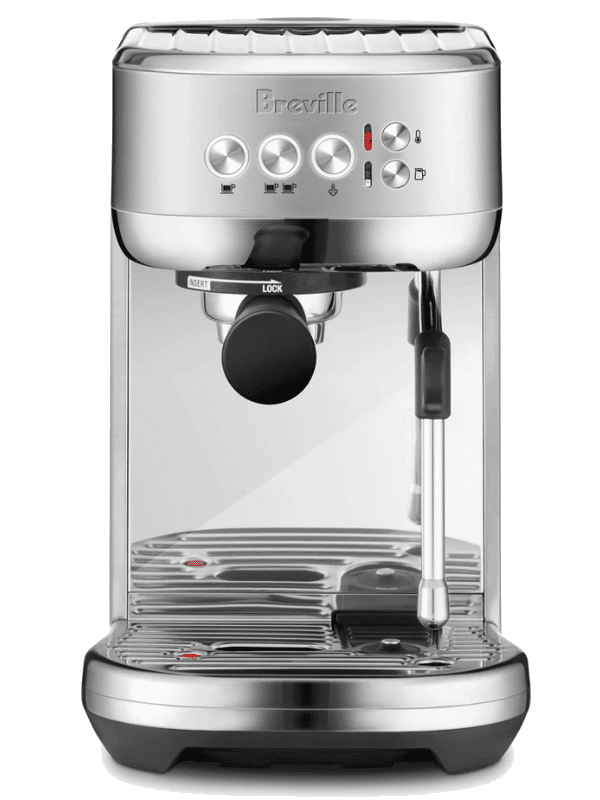
| Price | $$ |
| Type | Semi-automatic |
| Dimensions | 7.6 x 12.5 x 12.2 in (D, W, H) |
| Bars of pressure | 15 bars |
| Boiler type | single |
| Warranty | 1 year |
| Milk frother | Yes |
| Water capacity | 64 oz or 64 solo shots |
Pros
- Compact & sleek design
- Fast heat-up time
- Automatic milk frothing
- Precise temperature control
Cons
- Expensive price
- Small water tank
- No built-in grinder
Breville has a great international warranty. Making it a great choice for Australians, though most options on this list will also work.
The water reservoir’s huge and removable. The former perk prevents you from needing to refill often. And the latter makes it easier to clean and refill.
It has 9–15 bars of pressure, an ideal amount that ensures your drink has a consistent and flavorful taste. The included digital temperature control (PID) technology controls your drink’s temperatures to ensure a balanced coffee extraction.
Again, resulting in a better taste.
Due to its larger size, it may not be the best option for tiny kitchens.
If you want to make cappuccinos and lattes, but don’t want to do it by hand, the Bambino Plus includes an automatic micro-foam milk texture(er). Meaning, it’ll give you microfoam that’ll give drinks a silky texture. Or a base for latte art.
8. De’Longhi Bar: Best Small Espresso Machine Canada
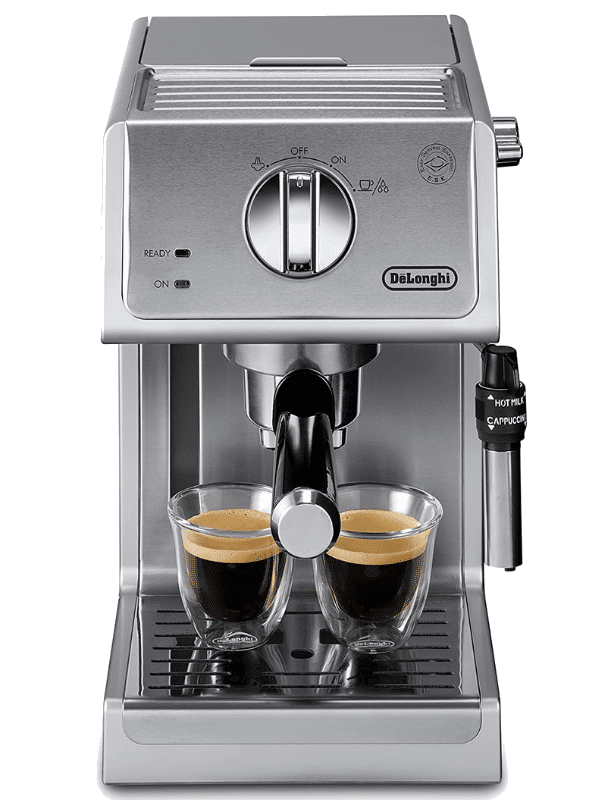
| Price | $$ |
| Type | Semi-automatic |
| Dimensions | 24.38 x 18.29 x 30.23 cm (D, W, H) |
| Bars of pressure | 15 bars |
| Boiler type | single |
| Warranty | 6 months |
| Milk frother | Yes |
| Water capacity | 1 liter or 35 solo shots |
Pros
- Adjustable controls
- Removable water tank & drip tray
Cons
- No additional color options
- Noisy when brewing or steaming milk
De’Longhi offers a decent warranty window for Canadians, making this device easy to recommend for folks living in Canada. If it isn’t for you, consider one of the other options mentioned.
Aside from warranties, the Bar doesn’t cost much, yet it includes various features like; a milk frother, removable water tank, ESE pod support, and 15 bars of pressure. The pressure amount is optimal for baristas (beginners and experts).
Easy Serve Espresso (ESE) pods are pre-packaged and ground coffee beans that’ll prevent you from grinding and tampering your beans. Great for anyone with some extra money who is always in a hurry.
But at that point, you might be better off buying a capsule coffee maker.
The removable water tank makes filling and cleaning your reservoir easier. And the milk frother is essential for brewing milk-based drinks.
9. De’Longhi Dedica: Best Small Espresso Machine UK
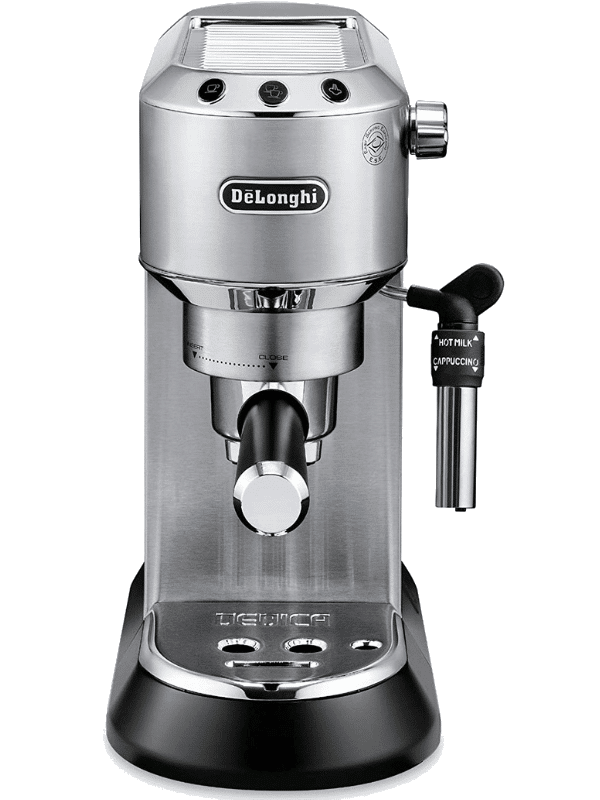
| Price | $$$ |
| Type | Semi-automatic |
| Dimensions | 15 x 33 x 30.5 cm (D, W, H) |
| Bars of pressure | 15 bars |
| Boiler type | thermoblock |
| Warranty | 6 months |
| Milk frother | Yes |
| Water capacity | 1 lter or 35 solo shots |
Pros
- Choose between single or double shots
- Thermoblock heating system
- Durable materials
Cons
- Noisy when brewing or steaming milk
- Lacks color options
Aside from supporting plug outlets in the United Kingdom, the Dedica also has a decent 6-month warranty outside the United States.
I doubt you’ll need to worry about using the warranty, though. The stainless steel materials used for this espresso maker shouldn’t disappoint.
Regardless of where you’re from, this machine’s decent for beginners graduating into “intermediate” status due to its adjustable milk frother and flow stop function. The latter function allows you to personalize your coffee length.
Speaking of size.
It has an adjustable drip tray, making it ideal for large- and small espresso cups. Then its compact size, yet aesthetically-pleasing design, makes it ideal for folks with small kitchens who want a conversation piece.
Small Espresso Machine Buying Guide
This buyer’s guide will cover criteria like:
- Pressure: Needed for extraction.
- Size: Whether it’ll fit in your home.
- Price: What impacts pricing.
- Brewing capabilities: What you can brew.
- Time to warm up: How long it’ll take before you can brew.
- Maintenance & cleaning: Ways to spend less time on cleaning.
- Heating: The time it takes to heat your water.
I’ll talk about how to build criteria in each category and how each will impact your drink’s flavor.
If you want to learn more, read our article on espresso machines buying guide.
1. Espresso Machine Pressure
Consider these factors when shopping for your small espresso machine:
- Opt for a machine with 9–15 bars of pressure: This range offers optimal extraction.
- Anything lower may result in under-extraction; less flavor.
- Higher pressures may lead to over-extraction; pulls too much flavor from beans.
- Look for adjustable pressure settings: Customize your espresso experience.
- Check if the machine has a pressure gauge: Monitor extraction for consistent results.
The ideal pressure for extracting espresso is 9 bars, but some machines boast up to 15 bars for that extra kick [1]. With the right pressure, you’ll achieve a delicious, balanced cup every time.
Picking a machine with proper pressure is crucial to unlocking the full flavor potential of your coffee. A low-pressure machine might yield a weak, under-extracted shot. Too much pressure could lead to over-extraction and bitterness.
The size of the machine doesn’t affect the amount of pressure it’ll have available.
The trick lies in finding the sweet spot.
2. Machine Size
Consider the following points when choosing your small espresso machine:
- Measure available counter space: Ensure the machine fits comfortably.
- Check machine dimensions: Compare with your available space.
- Assess water capacity: Smaller machines require more frequent refilling.
- Examine machine weight: Lightweight options are easier to move & clean.
Aim for a compact, lightweight design that fits seamlessly into your kitchen without compromising on performance.
Smaller machines might have less capacity for water and coffee beans. Thus, prepare yourself to refill them more often.
3. Machine Price
Several factors affect an espresso machine’s price:
- Type of machine: More automation typically means higher cost.
- Features: Extra options like built-in grinders or milk frothers increase price.
- Materials: Higher quality materials, such as stainless steel, raise the price.
- Brand name: Prestigious brands regularly command a premium.
- Built-in grinder: Super-automatic espresso makers include these.
- Other machine types will require you to buy a separate coffee bean grinder.
- Boiler types: Machines with thermoblock and single boilers cost much less than those with double boilers.
- I cover the differences in a couple of sections.
The type of machine, its features, and the brand name all play a role in determining the cost. On average, manual machines cost around $200. Super-automatic ones could set you back up to $3,000.
Smaller machines may have less quality-of-life features, making them more affordable than their larger counterparts.
Here’s a comparison as to how much (on average) different espresso machine types will cost:
- Manual: $200–$1,000
- Semi-automatic: $100–$1,500
- Automatic: $500–$2,000
- Fully-automatic: $800–$2,500
- Super-automatic: $1,000–$3,000
On to brewing.
4. Brewing Capabilities
Consider these factors when comparing brewing capabilities:
- Espresso shot options: Check if the machine prepares ristretto, doppio, or lungo.
- Milk-based drinks: Ensure the machine allows for cappuccinos, lattes, & more.
- Temperature control: Optimal brewing temperature affects flavor & quality.
- Programmability: Customizable settings for personalization.
You want a machine that suits your coffee preferences, but remember that not all machines automatically prepare ristretto, doppio, and lungo.
Does the machine’s size affect the way it’ll brew your coffee? It depends on the manufacturer and the way they designed the maker. In most cases, you shouldn’t notice too much of a difference versus larger machines.
But it all depends on what that specific model sacrifices for size.
Here’s all the coffee drinks espresso machines can make:
| Red Eye | Espresso Romano | Marocchino |
| Manilo Long Black | Macchiato | Zorro |
| Lazy Eye | Vienna Coffee | Cubano |
| Latte | Café Breve | Mocha |
| Flat White | Café Medici | Affogato al Caffe |
| Dripped Eye | Irish Coffee | Freddo Cappuccino |
| Cappuccino | Galão | Café Crema |
| Black Eye | Guillermo | Rápido y Sucio |
| Americano | Cortado | Long macchiato |
5. Time to Warm Up
Keep these points in mind when evaluating warm-up time:
- Quick warm-up machines: Aim for models that heat up in under a minute.
- The sooner it warms, the quicker you could make drinks for others.
- Boiler type: Single, thermoblock, or double boilers influence the time it takes to reach optimal temperature.
- Pre-infusion: Some machines offer a pre-infusion feature, extending warm-up time but improving flavor extraction.
Does size affect how long it’ll take for the machine to warm up? It depends on the boiler included. Thermoblock boilers will heat quicker than single boilers. And double boilers will heat quicker than both.
However, many double boiler espresso machines are meant for commercial purposes. It’s likely you won’t find one of these available.
The time required for your espresso machine to warm up directly impacts your daily routine. Prioritize machines with shorter warm-up times to enjoy your coffee without delays.
6. Cleaning & Maintenance
Consider these factors when evaluating cleaning & maintenance:
- Removable parts: Look for machines with easy-to-remove drip trays, water reservoirs, & brewing units.
- Self-cleaning cycles: Machines with this feature simplify maintenance.
- Descaling process: Choose a model with straightforward descaling instructions.
- Watch YouTube videos to see what it’s like descaling the machine you want.
- External cleaning: Opt for a machine with a finish that’s easy to wipe clean (e.g., stainless steel).
The size of an espresso machine doesn’t impact how long it’ll take to clean. Sure, you’ll have a bit less surface area, but that’s the main difference. The biggest time-saver comes from whether it has removable components.
Otherwise, you’ll need to dig through your machine to deep clean it.
When shopping for your small espresso machine, pay attention to how easy it is to clean and maintain.
Some machines feature self-cleaning cycles or removable parts, making maintenance a breeze. Others may require more hands-on cleaning, like using a brush to clean the group head.
You should descale espresso machines every 3 to 4 months [2]. The same doesn’t apply to manual espresso makers. Since they don’t have water pumps and filters.
7. Heating
Let’s review what heating options espresso machines have:
- Thermoblock heaters: Mid-range cost, heats on-demand, and heats faster than single boilers [3].
- Great balance between price & heating speed.
- Single boiler: Costs less & a much longer wait time between brews.
- Ideal for saving money.
- Double boilers: Heats the quickest, but costs the most.
- Best for brewing multiple drinks back-to-back.
Most options I covered include thermoblock heaters or single boilers. You likely won’t find double boilers, unless willing to blow more than $500.
Different Types of Espresso Makers Compared
Here is an overview of the different types of espresso machines. To learn more, read our article on the subject.
1. Manual Espresso Makers
Manual espresso makers are best suited for coffee purists and hands-on enthusiasts. They require you to control all aspects of the brewing process, from grinding the beans to tamping and pulling the shot.
Some manual makers, like the NEO, are much larger than other models under the same category. But come with carrying cases, which makes them easier to store. However, I’ve seen many other off-brand manual makers that can accommodate smaller counters.
The average price ranges from $100 to $1,000.
2. Automatic Espresso Makers
Automatic espresso makers regulate water flow and brewing time, taking some guesswork out of the process. They’re suitable for those who want consistent espresso with minimal manual input.
The size of these machines will vary by model. You may find some that’ll fit in small counterspaces. And others that’ll require its own coffee cart.
They usually cost $500–$2,000.
3. Semi-automatic Espresso Makers
Semi-automatic espresso makers offer a balance between control and automation. You decide when to start and stop the water flow, giving you creative freedom. They’re ideal for coffee lovers seeking customization without full manual control.
These machines are generally the most compact due to not having as many features as their fully- and super-automatic counterparts.
And they cost (on average) around $150 to $1,500.
4. Fully-automatic Espresso Makers
Fully-automatic espresso makers automate water flow, brewing time, and sometimes tamping. They’re perfect for users who prioritize convenience and speed, with prices ranging from $800 to $2,500.
And they’re slightly larger than semi-automatic makers. It depends on the model you get.
5. Super-automatic Espresso Makers
Super-automatic espresso makers take care of brewing, from grinding to frothing milk. They’re suitable for those seeking ultimate convenience and are willing to pay a premium, costing between $1,000 and $3,000.
Size-wize, these are the largest machines. Since they have so many built-in features (e.g., grinder).
6. Capsule Espresso Machines
Capsule espresso machines use pre-packaged coffee pods, offering a mess-free and straightforward brewing process. They’re best for busy individuals who want a quick, consistent espresso with minimal fuss.
These usually fit in narrow countertops, since they don’t have as many features as traditional espresso machines (e.g., grinders and frothers).
Prices vary, from under $100 for basic models to over $600 for high-end machines.
Pros & Cons of Using Small Espresso Machines
Small espresso machines offer several advantages and drawbacks compared to their regular-sized counterparts. When deciding on the perfect machine for your home, it’s essential to consider both aspects.
Pros of small espresso machines:
- Space-saving: Compact designs fit easily on limited counter space.
- Lightweight: Easier to move & clean than larger machines.
- Lower cost: Often more affordable than larger, feature-packed models.
- Faster warm-up: Smaller boilers typically heat up more quickly.
Cons of small espresso machines:
- Limited capacity: Smaller water reservoirs & bean hoppers require more frequent refilling.
- Fewer features: Compact machines may lack advanced options like built-in grinders or milk frothers.
- Potentially less durable: Smaller machines may use less robust materials to save on weight & cost.
On to regular-sized machines—
Pros of regular-sized espresso machines:
- Greater capacity: Larger water reservoirs & bean hoppers reduce the need for constant refilling.
- More features: Advanced options like programmable settings & temperature control are more common.
- Better durability: Regular-sized machines often use higher-quality materials, enhancing longevity.
Cons of regular-sized espresso machines:
- Space-consuming: Require more counter space, which may not suit smaller kitchens.
- Heavier: More challenging to move & clean due to increased weight.
- Higher cost: Feature-packed machines typically come with a higher price tag.
Weigh the pros and cons of small and regular-sized espresso machines, then it’ll be easier for you to decide what you want.
Conclusion
The AeroPress produces an espresso-like coffee that works perfectly for folks traveling within their home country or abroad. And the PHILIPS 3200 will give you a somewhat small super-automatic espresso-brewing experience.
Those who want a beginner-friendly, affordable, and somewhat automated experience will want the De’Longhi Stilosa.
Get it now.

